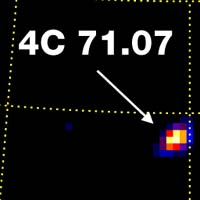
A | B | C | D | E | F | G | H | CH | I | J | K | L | M | N | O | P | Q | R | S | T | U | V | W | X | Y | Z | 0 | 1 | 2 | 3 | 4 | 5 | 6 | 7 | 8 | 9
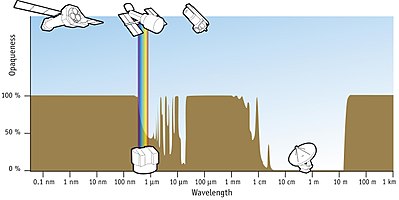
Astrophysical X-ray sources are astronomical objects with physical properties which result in the emission of X-rays.
Several types of astrophysical objects emit X-rays. They include galaxy clusters, black holes in active galactic nuclei (AGN), galactic objects such as supernova remnants, stars, and binary stars containing a white dwarf (cataclysmic variable stars and super soft X-ray sources), neutron star or black hole (X-ray binaries). Some Solar System bodies emit X-rays, the most notable being the Moon, although most of the X-ray brightness of the Moon arises from reflected solar X-rays.
Furthermore, celestial entities in space are discussed as celestial X-ray sources. The origin of all observed astronomical X-ray sources is in, near to, or associated with a coronal cloud or gas at coronal cloud temperatures for however long or brief a period.
A combination of many unresolved X-ray sources is thought to produce the observed X-ray background. The X-ray continuum can arise from bremsstrahlung, either magnetic or ordinary Coulomb, black-body radiation, synchrotron radiation, inverse Compton scattering of lower-energy photons by relativistic electrons, knock-on collisions of fast protons with atomic electrons, and atomic recombination, with or without additional electron transitions.[1]
Galaxy clusters
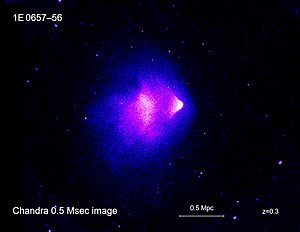
Clusters of galaxies are formed by the merger of smaller units of matter, such as galaxy groups or individual galaxies. The infalling material (which contains galaxies, gas and dark matter) gains kinetic energy as it falls into the cluster's gravitational potential well. The infalling gas collides with gas already in the cluster and is shock heated to between 107 and 108 K depending on the size of the cluster. This very hot gas emits X-rays by thermal bremsstrahlung emission, and line emission from metals (in astronomy, 'metals' often means all elements except hydrogen and helium). The galaxies and dark matter are collisionless and quickly become virialised, orbiting in the cluster potential well.
At a statistical significance of 8σ, it was found that the spatial offset of the center of the total mass from the center of the baryonic mass peaks cannot be explained with an alteration of the gravitational force law.[2]
Quasars
A quasi-stellar radio source (quasar) is a very energetic and distant galaxy with an active galactic nucleus (AGN). QSO 0836+7107 is a Quasi-Stellar Object (QSO) that emits baffling amounts of radio energy. This radio emission is caused by electrons spiraling (thus accelerating) along magnetic fields producing cyclotron or synchrotron radiation. These electrons can also interact with visible light emitted by the disk around the AGN or the black hole at its center. These photons accelerate the electrons, which then emit X- and gamma-radiation via Compton and inverse Compton scattering.
On board the Compton Gamma Ray Observatory (CGRO) is the Burst and Transient Source Experiment (BATSE) which detects in the 20 keV to 8 MeV range. QSO 0836+7107 or 4C 71.07 was detected by BATSE as a source of soft gamma rays and hard X-rays. "What BATSE has discovered is that it can be a soft gamma-ray source", McCollough said. QSO 0836+7107 is the faintest and most distant object to be observed in soft gamma rays. It has already been observed in gamma rays by the Energetic Gamma Ray Experiment Telescope (EGRET) also aboard the Compton Gamma Ray Observatory.[3]
Seyfert galaxies
Seyfert galaxies are a class of galaxies with nuclei that produce spectral line emission from highly ionized gas.[4] They are a subclass of active galactic nuclei (AGN), and are thought to contain supermassive black holes.[4]
X-ray bright galaxies
The following early-type galaxies (NGCs) have been observed to be X-ray bright due to hot gaseous coronae: NGC 315, 1316, 1332, 1395, 2563, 4374, 4382, 4406, 4472, 4594, 4636, 4649, and 5128.[5] The X-ray emission can be explained as thermal bremsstrahlung from hot gas (0.5–1.5 keV).[5]
Ultraluminous X-ray sources
Ultraluminous X-ray sources (ULXs) are pointlike, nonnuclear X-ray sources with luminosities above the Eddington limit of 3 × 1032 W for a 20 M☉ black hole.[6] Many ULXs show strong variability and may be black hole binaries. To fall into the class of intermediate-mass black holes (IMBHs), their luminosities, thermal disk emissions, variation timescales, and surrounding emission-line nebulae must suggest this.[6] However, when the emission is beamed or exceeds the Eddington limit, the ULX may be a stellar-mass black hole.[6] The nearby spiral galaxy NGC 1313 has two compact ULXs, X-1 and X-2. For X-1 the X-ray luminosity increases to a maximum of 3 × 1033 W, exceeding the Eddington limit, and enters a steep power-law state at high luminosities more indicative of a stellar-mass black hole, whereas X-2 has the opposite behavior and appears to be in the hard X-ray state of an IMBH.[6]
Black holes
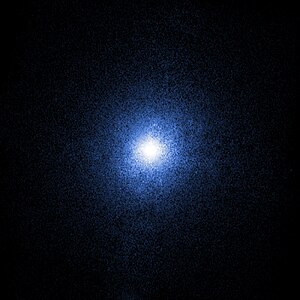
Black holes give off radiation because matter falling into them loses gravitational energy which may result in the emission of radiation before the matter falls into the event horizon. The infalling matter has angular momentum, which means that the material cannot fall in directly, but spins around the black hole. This material often forms an accretion disk. Similar luminous accretion disks can also form around white dwarfs and neutron stars, but in these the infalling gas releases additional energy as it slams against the high-density surface with high speed. In case of a neutron star, the infall speed can be a sizeable fraction of the speed of light.
In some neutron star or white dwarf systems, the magnetic field of the star is strong enough to prevent the formation of an accretion disc. The material in the disc gets very hot because of friction, and emits X-rays. The material in the disc slowly loses its angular momentum and falls into the compact star. In neutron stars and white dwarfs, additional X-rays are generated when the material hits their surfaces. X-ray emission from black holes is variable, varying in luminosity in very short timescales. The variation in luminosity can provide information about the size of the black hole.
Supernova remnants (SNR)
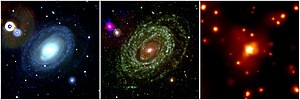 |
 |
A Type Ia supernova is an explosion of a white dwarf in orbit around either another white dwarf or a red giant star. The dense white dwarf can accumulate gas donated from the companion. When the dwarf reaches the critical mass of 1.4 M☉, a thermonuclear explosion ensues. As each Type Ia shines with a known luminosity, Type Ia are used as "standard candles" to measure distances in the universe.
SN 2005ke is the first Type Ia supernova detected in X-ray wavelengths, and it is much brighter in the ultraviolet than expected.
X-ray emission from stars
Vela X-1
Vela X-1 is a pulsing, eclipsing high-mass X-ray binary (HMXB) system, associated with the Uhuru source 4U 0900-40 and the supergiant star HD 77581. The X-ray emission of the neutron star is caused by the capture and accretion of matter from the stellar wind of the supergiant companion. Vela X-1 is the prototypical detached HMXB.[7]
Hercules X-1

An intermediate-mass X-ray binary (IMXB) is a binary star system where one of the components is a neutron star or a black hole. The other component is an intermediate mass star.[8]
Hercules X-1 is composed of a neutron star accreting matter from a normal star (HZ Her) probably due to Roche lobe overflow. X-1 is the prototype for the massive X-ray binaries although it falls on the borderline, ~2 M☉, between high- and low-mass X-ray binaries.[9]
Scorpius X-1
The first extrasolar X-ray source was discovered on 12 June 1962.[10] This source is called Scorpius X-1, the first X-ray source found in the constellation of Scorpius, located in the direction of the center of the Milky Way. Scorpius X-1 is some 9,000 ly from Earth and after the Sun is the strongest X-ray source in the sky at energies below 20 keV. Its X-ray output is 2.3 × 1031 W, about 60,000 times the total luminosity of the Sun.[11] Scorpius X-1 itself is a neutron star. This system is classified as a low-mass X-ray binary (LMXB); the neutron star is roughly 1.4 solar masses, while the donor star is only 0.42 solar masses.[12]
Sun
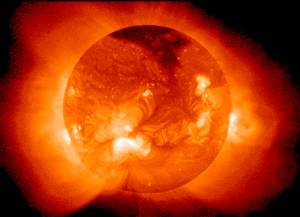
In the late 1930s, the presence of a very hot, tenuous gas surrounding the Sun was inferred indirectly from optical coronal lines of highly ionized species.[13] In the mid-1940s radio observations revealed a radio corona around the Sun.[13] After detecting X-ray photons from the Sun in the course of a rocket flight, T. Burnight wrote, "The sun is assumed to be the source of this radiation although radiation of wavelength shorter than 4 Å would not be expected from theoretical estimates of black body radiation from the solar corona."[13] And, of course, people have seen the solar corona in scattered visible light during solar eclipses.
While neutron stars and black holes are the quintessential point sources of X-rays, all main sequence stars are likely to have hot enough coronae to emit X-rays.[14] A- or F-type stars have at most thin convection zones and thus produce little coronal activity.[15]
Similar solar cycle-related variations are observed in the flux of solar X-ray and UV or EUV radiation. Rotation is one of the primary determinants of the magnetic dynamo, but this point could not be demonstrated by observing the Sun: the Sun's magnetic activity is in fact strongly modulated (due to the 11-year magnetic spot cycle), but this effect is not directly dependent on the rotation period.[13]
Solar flares usually follow the solar cycle. CORONAS-F was launched on 31 July 2001 to coincide with the 23rd solar cycle maximum. The solar flare of 29 October 2003 apparently showed a significant degree of linear polarization (> 70% in channels E2 = 40–60 keV and E3 = 60–100 keV, but only about 50% in E1 = 20–40 keV) in hard X-rays,[16] but other observations have generally only set upper limits.

Coronal loops form the basic structure of the lower corona and transition region of the Sun. These highly structured and elegant loops are a direct consequence of the twisted solar magnetic flux within the solar body. The population of coronal loops can be directly linked with the solar cycle, it is for this reason coronal loops are often found with sunspots at their footpoints. Coronal loops populate both active and quiet regions of the solar surface. The Yohkoh Soft X-ray Telescope (SXT) observed X-rays in the 0.25–4.0 keV range, resolving solar features to 2.5 arc seconds with a temporal resolution of 0.5–2 seconds. SXT was sensitive to plasma in the 2–4 MK temperature range, making it an ideal observational platform to compare with data collected from TRACE coronal loops radiating in the EUV wavelengths.[17]
Variations of solar-flare emission in soft X-rays (10–130 nm) and EUV (26–34 nm) recorded on board CORONAS-F demonstrate for most flares observed by CORONAS-F in 2001–2003 UV radiation preceded X-ray emission by 1–10 min.[18]
White dwarfs
When the core of a medium mass star contracts, it causes a release of energy that makes the envelope of the star expand. This continues until the star finally blows its outer layers off. The core of the star remains intact and becomes a white dwarf. The white dwarf is surrounded by an expanding shell of gas in an object known as a planetary nebula. Planetary nebula seem to mark the transition of a medium mass star from red giant to white dwarf. X-ray images reveal clouds of multimillion degree gas that have been compressed and heated by the fast stellar wind. Eventually the central star collapses to form a white dwarf. For a billion or so years after a star collapses to form a white dwarf, it is "white" hot with surface temperatures of ~20,000 K.
X-ray emission has been detected from PG 1658+441, a hot, isolated, magnetic white dwarf, first detected in an Einstein IPC observation and later identified in an Exosat channel multiplier array observation.[19] "The broad-band spectrum of this DA white dwarf can be explained as emission from a homogeneous, high-gravity, pure hydrogen atmosphere with a temperature near 28,000 K."[19] These observations of PG 1658+441 support a correlation between temperature and helium abundance in white dwarf atmospheres.[19]
A super soft X-ray source (SSXS) radiates soft X-rays in the range of 0.09 to 2.5 keV. Super soft X-rays are believed to be produced by steady nuclear fusion on a white dwarf's surface of material pulled from a binary companion.[20] This requires a flow of material sufficiently high to sustain the fusion.
Real mass transfer variations may be occurring in V Sge similar to SSXS RX J0513.9-6951 as revealed by analysis of the activity of the SSXS V Sge where episodes of long low states occur in a cycle of ~400 days.[21]
HD 49798 is a subdwarf star that forms a binary system with RX J0648.0-4418. The subdwarf star is a bright object in the optical and UV bands. The orbital period of the system is accurately known. Recent XMM-Newton observations timed to coincide with the expected eclipse of the X-ray source allowed an accurate determination of the mass of the X-ray source (at least 1.2 solar masses), establishing the X-ray source as a rare, ultra-massive white dwarf.[22]
Brown dwarfs
According to theory, an object that has a mass of less than about 8% of the mass of the Sun cannot sustain significant nuclear fusion in its core.[23] This marks the dividing line between red dwarf stars and brown dwarfs. The dividing line between planets and brown dwarfs occurs with objects that have masses below about 1% of the mass of the Sun, or 10 times the mass of Jupiter. These objects cannot fuse deuterium.

LP 944-20
With no strong central nuclear energy source, the interior of a brown dwarf is in a rapid boiling, or convective state. When combined with the rapid rotation that most brown dwarfs exhibit, convection sets up conditions for the development of a strong, tangled magnetic field near the surface. The flare observed by Chandra from LP 944-20 could have its origin in the turbulent magnetized hot material beneath the brown dwarf's surface. A sub-surface flare could conduct heat to the atmosphere, allowing electric currents to flow and produce an X-ray flare, like a stroke of lightning. The absence of X-rays from LP 944-20 during the non-flaring period is also a significant result. It sets the lowest observational limit on steady X-ray power produced by a brown dwarf star, and shows that coronas cease to exist as the surface temperature of a brown dwarf cools below about 2500 °C and becomes electrically neutral.
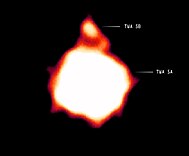
TWA 5B
Using NASA's Chandra X-ray Observatory, scientists have detected X-rays from a low mass brown dwarf in a multiple star system.[24] This is the first time that a brown dwarf this close to its parent star(s) (Sun-like stars TWA 5A) has been resolved in X-rays.[24] "Our Chandra data show that the X-rays originate from the brown dwarf's coronal plasma which is some 3 million degrees Celsius", said Yohko Tsuboi of Chuo University in Tokyo.[24] "This brown dwarf is as bright as the Sun today in X-ray light, while it is fifty times less massive than the Sun", said Tsuboi.[24] "This observation, thus, raises the possibility that even massive planets might emit X-rays by themselves during their youth!"[24]
X-ray reflection
 Text je dostupný za podmienok Creative Commons Attribution/Share-Alike License 3.0 Unported; prípadne za ďalších podmienok. Podrobnejšie informácie nájdete na stránke Podmienky použitia.
Analytika
Antropológia Aplikované vedy Bibliometria Dejiny vedy Encyklopédie Filozofia vedy Forenzné vedy Humanitné vedy Knižničná veda Kryogenika Kryptológia Kulturológia Literárna veda Medzidisciplinárne oblasti Metódy kvantitatívnej analýzy Metavedy Metodika Text je dostupný za podmienok Creative
Commons Attribution/Share-Alike License 3.0 Unported; prípadne za ďalších
podmienok. www.astronomia.sk | www.biologia.sk | www.botanika.sk | www.dejiny.sk | www.economy.sk | www.elektrotechnika.sk | www.estetika.sk | www.farmakologia.sk | www.filozofia.sk | Fyzika | www.futurologia.sk | www.genetika.sk | www.chemia.sk | www.lingvistika.sk | www.politologia.sk | www.psychologia.sk | www.sexuologia.sk | www.sociologia.sk | www.veda.sk I www.zoologia.sk |

